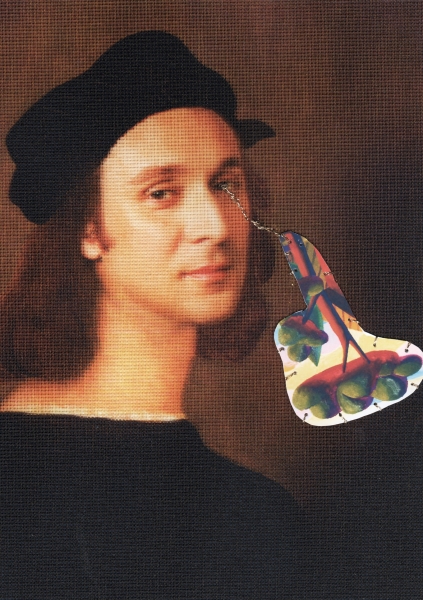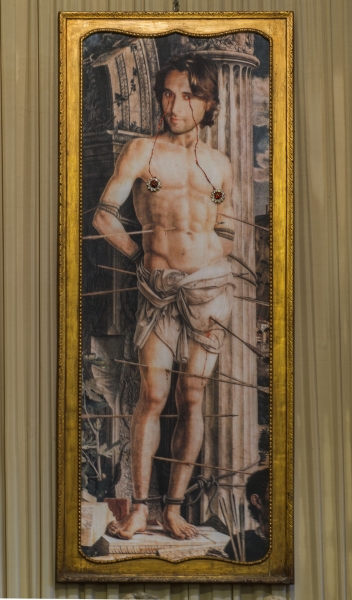
Tears, apparently, are not only out of fashion but also underrepresented in the history of art—and Francesco Vezzoli won’t have it. Despite the glamorous veneer of his public persona, Vezzoli is actually quite the scholar. After obsessive research, he couldn’t find any paintings, from Old Masters or contemporary practitioners, depicting tearful effluviums of any kind. So he addressed the lack of imagery in the lacrimosa department his own way.
His new exhibition at Venice Museo Correr, whose opening coincided with that of the 60th Biennale, is called “Musei delle Lacrime” (“Museums of Tears”). Staged in salons where Renaissance masterpieces are exhibited in a daring modernist setting—the Correr was designed in the 1950s by Italian architect Carlo Scarpa—Vezzoli’s tearful oeuvres are a radical, almost iconoclastic pop-take on classic artworks. Quite the craftsman, Vezzoli has hand-embroidered and bejeweled tears on the faces of Lady Gaga, Kim Kardashian, and Christie Brinkley, and superimposed them on portraits by the likes of Giovanni Bellini, Giotto, and Artemisia Gentileschi. Embroidery, for Vezzoli, is an intimate practice, challenging normative notions of masculinity and femininity, as the exhibition’s curator Donatien Grau, the Head of Contemporary Programs at the Louvre Museum, points out.
This is Vezzoli’s most ambitious project to date, one in which he challenges himself against art history giants, and pays devoted, yet rather cocky, homage to the modernist allure of Scarpa’s museum design. I sat down with him to talk about the exhibition, for which he recorded an informative audio guide, walking visitors through 14 rooms where his work sits alongside a storied collection of Venetian art, spanning from the 13th to the 17th century.
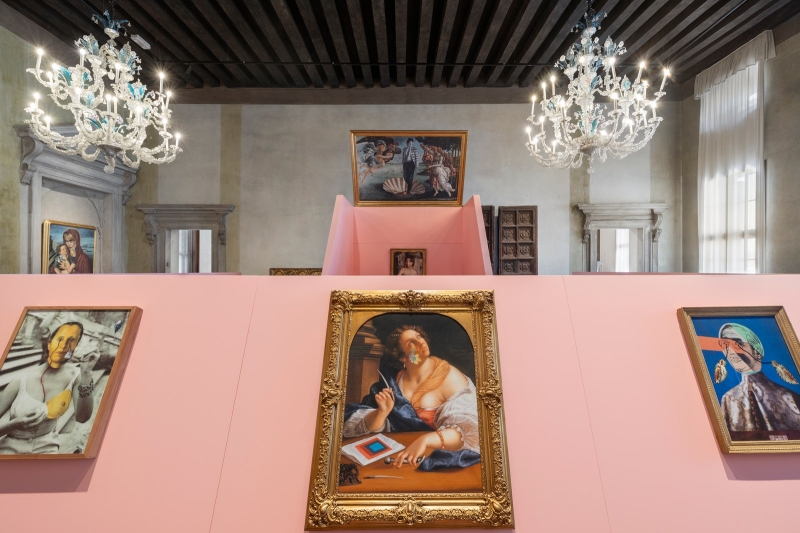
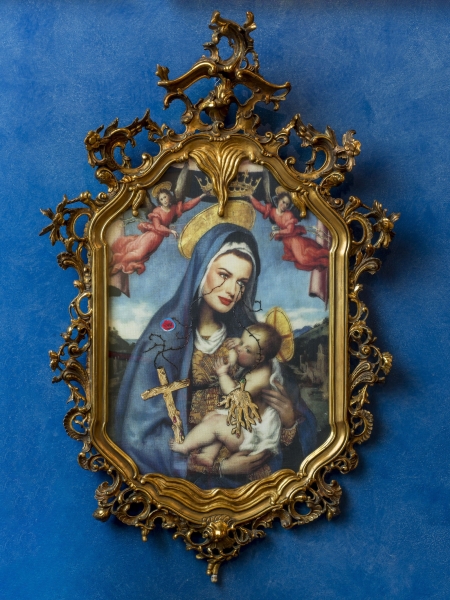
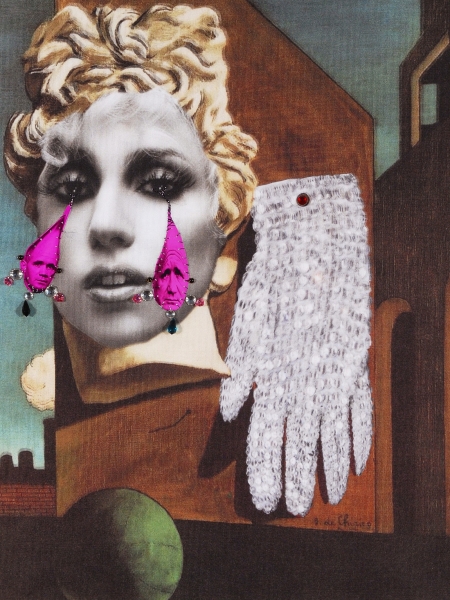
Tell me about how the exhibition came about.
To use a daring metaphor, it has been like giving birth through a Caesarean section — man born from man! A huge effort and honor. When I was proposed to set up an exhibition at Museo Correr in the salons that Carlo Scarpa renovated in the 1950s, I almost fainted for the emotion. In these spaces nothing can be touched, changed or moved around, as everything has to stay exactly as Scarpa imagined it. It’s not like other museums where you can modify the layout according to your project. The Museo Correr is a rare case of historicized museology, it’s like a sacred place; for me it’s one of the most religious places in the history of art and architecture.
How did you adapt your artworks in this extraordinary yet rather challenging setting?
The first thing I asked myself was: What the hell am I going to show to face such a huge challenge, to stand against not only Scarpa, but Carpaccio, Giotto, or Bellini? You know, if you challenge Michelangelo imagery, let’s say you are already in a sort of Pop zone, as his repertoire has been vastly appropriated by Pop culture. But these masterpieces, often small in size, priceless and über-precious, are almost at the origin of the art of painting as we know it, so confronting them it’s an even greater challenge. In my 30-year career, I’ve never imagined to be given the opportunity to do such an exhibition.
Where does this obsession with tears come from?
The question about tears is always the most difficult to answer. I can answer with a quote from the Latin poet Virgil: Sunt Lacrima Rerum, which roughly translates into “ there are tears in (or for) things.” I can talk about melancholy, although it’s a subject I try never to tap into because it has to do with profoundly private feelings that I’m not keen to reveal…Tears have been a defining subject of my work from the very beginning, since the Veruschka portrait and my first Biennale…After meticulous researches, I’ve concluded that in art history tears have never been actually represented; in classical paintings pain or sorrow or despair are usually depicted hiding or averting the eyes. I’ve toured every possible museum, but no tears in sight. That said, I haven’t strategized to show tears in my work, I’m not an entrepreneur who says, great, there’s a niche where tears are lacking, it’s a business opportunity I want to exploit. It came natural to me. Tears are a sort of emotional acme, and I’m not about manifestos on patriarchy, but art has always been the prerogative of male culture, and men have never felt the need to represent tears, that are such an intimate, mysterious secretion. Women embroider, men paint. No tears.
For this exhibition you’ve recorded an audio guide to walk visitors through the exhibition; it’s quite unusual hearing the voice of the artist personally explaining his work to the audience.
I intended this exhibition as experiential. I believe that people visiting it do not ask themselves: do I like it or not? Rather, I’d like they feel an emotion that won’t be repeated, perhaps they’ll feel disgusted or annoyed, perhaps they’ll think me arrogant and cocky—but they will experience [something unique], as this exhibition as it has been set up in this specific site, with such intentional display of old masters set against my work, it won’t be replicated anywhere else. This is truly important to me, as I believe that in our digital times only experiential exhibitions have a raison d’être. As artists, it’s an intellectual challenge we’re facing today: we ask a lot from our audiences — especially in this moment, when they’ve got more pivotal, pressing issues vying for their attention. So we have to give them something unique, and worthy, valuable. If as artists we only display our work in white cubes, elevating it on self-centered pedestals that can be set up everywhere, framing our exhibition in a de-historicized context — it’s not what I am about. The relationship with history is a much deeper level of artistic engagement, and, yes, you can think me arrogant, but I believe it’s actually giving it a rather radical edge and gives great value to my artistic practice.
Of the many artworks displayed here, a veritable pantheon of Pop-culture superstars, which are the ones that most represent yourself?
Perhaps it’s the image of the embroidering Madonna, that I finally found after many years of research. From her needle I had tears radiating through the entire painting… and then there’s the image of Richard Gere as Botticelli’s Venus, coming out of the shell perfectly clad in Armani as in American Gigolo. Isn’t that fantasy of the gender-fluid gigolo appealing to all genders, and ingrained in our collective memory? But also the image of Kim Kardashian as a Madonna, inspired by the blue-veiled Virgin painted by Antonello da Messina…We’ve got to be culturally honest, and acknowledge what are in our times the new vectors of the sacred. Supermodels are a cultural patrimony, whether you like it or not. Fashion is the dominant system shaping our collective imagination, narration, and memory. Fashion has bought huge slices of Hollywood, actors and actresses are entrenched in the fashion system that gives enormous power to their image. The patrimony of fashion should find a place in the history of art. As artists, we have the duty to understand how this system has become so powerful, and confront it in our practice. Today kids want a Gucci bag they’ve seen on Linda Evangelista, not little toy cars as their fathers used to dream about. It’s a profoundly narcissistic language. But each form of capitalism has its own stars.
Francesco Vezzoli’s “Museums of Tears” is on view at Museo Correr, Venice, until November 24, 2024
